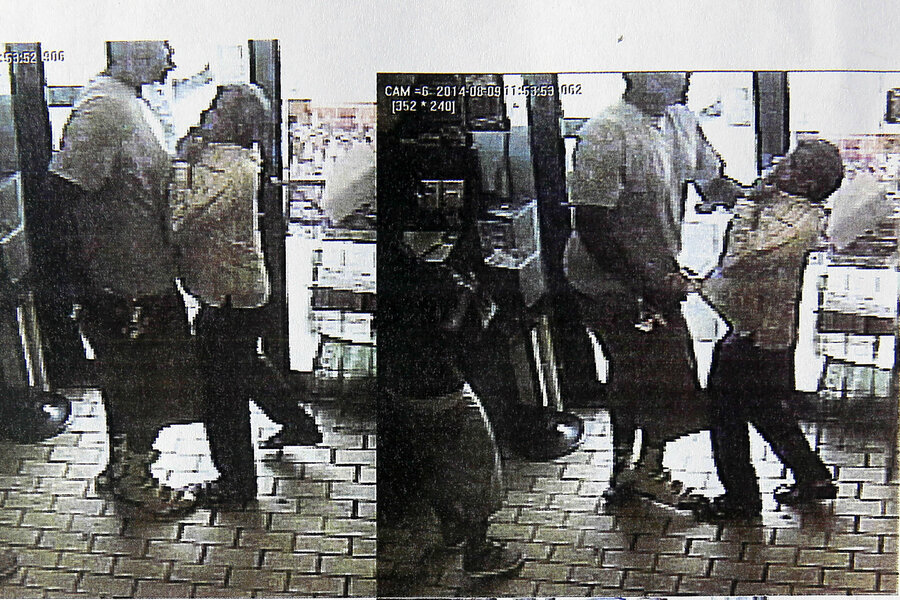Ferguson shooting: What's known now about Michael Brown
Was Michael Brown a "gentle giant," a cigar thief, or a gang member?
The black teenager had no adult criminal record, according to the St. Louis County prosecutor. Initial media profiles noted that family and friends described "Big Mike" as not "the type to fight" and "funny, silly, he would make you laugh."
"He was never a person who liked confrontation," said Markese Mull, who described himself as a close friend. "His smile was going to make you smile."
“We called him the gentle giant. He was a gentle giant,” Charles Ewing, Brown’s uncle, told the Washington Post.
His family tried to get him to play football. Brown was too timid for the sport, Mr. Ewing said.
Michael Brown had struggled in school, but had graduated Aug. 1 from Normandy High School, and had been staying at his grandmother's apartment in Ferguson this summer. Family members said that hre planned to start this past week at Vatterott Educational Centers, a vocational technical college, in pursuit of a career as a heating and air conditioning engineer.
But the portrait of Michael Brown emerging now contradicts some of those earlier portrayals of him as a "gentle giant."
According to a Ferguson police report released Friday, Mike Brown was the chief suspect in a robbery that occurred about 10 minutes before he was fatally shot.
The report says Brown was seen by witnesses and on video tape, carrying a box of cigars from a nearby liquor store.
Photos from the video footage released by police show a large man dressed in a T-shirt and red St. Louis Cardinals cap, the same clothing Mike Brown was wearing when he was killed, shoving the liquor store clerk.
A witness emerged from the bathroom to see the alleged robbery. “According to [name of witness redacted], [name of store cashier redacted ] was trying to lock the door until Brown returned the merchandise to him,” says the police report.
"Brown, still holding a box of Swisher Sweets [cigars] in his right hand, grabs [store cashier] by his shirt with his left hand. Brown aggressively pulls [the store clerk] in close to him and then immediately pushes him back into a display rack... Brown then abruptly turns back around and advances on [the store clerk] appearing to intimidate him," says the Ferguson police report, describing the video footage.
While the police report doesn't identify the store, media reports say it is Ferguson Market and Liquor. The store is now closed and on Friday evening hundreds of people had gathered at the location.
The police report says that the robbery occurred Saturday Aug. 9 between 11:52 and 11:54 a.m.
The report says Brown was accompanied by Dorian Johnson, the same individual later identified as being with Brown when they were stopped at 12:01 p.m. for "jaywalking" by Ferguson police officer Darren Wilson. Moments later, Brown was shot by Wilson.
There is no police video footage of the fatal encounter between Brown and Wilson, the police officer. Unlike many police departments, neither Ferguson police cars or officers are equipped with video cameras. The department reportedly received a federal grant recently to equip some patrol cars with cameras, but that hasn't occurred yet.
Ferguson Police Chief Thomas Jackson said Friday that Officer Wilson had no knowledge that Brown was a suspect in the robbery at the time he encountered Brown.
The release of the robbery report was “an attempt at character assassination," said Anthony Gray, a lawyer for Brown’s family, during a news conference Friday. “They feel it was aimed at denigrating their son."
Brown's family also released this statement Friday: “There is nothing based on the facts that have been placed before us that can justify the execution style murder of their child by this police officer as he held his hands up, which is the universal sign of surrender.”
In addition to the Ferguson police report, conservative blogger Pat Dollard published images of Michael Brown flashing gang signs, under the headline "EXPOSED: Michael Brown Was A Member Of The Ultraviolent ‘Bloods’ Street Gang."
Beyond these photos, there hasn't been any evidence released by the police or others indicating Brown was a gang member. But these photos and the Ferguson police report are changing the public portrait of Brown in conservative – and liberal – circles.
At The Daily Beast, deputy social media editor Aswin Suebsaeng wrote: "It should go without saying but vaguely intimidating photos of you do not give the police carte blanche to gun you down, and we no longer live in a country where it is OK to sentence black men to death for the crime of petty theft."







